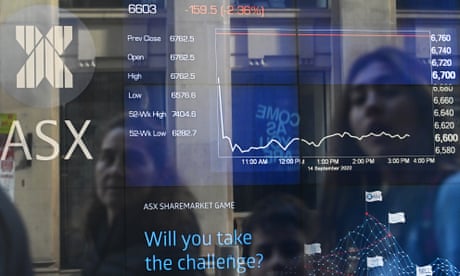- by foxnews
- 02 Feb 2025
What experts think of the RBA’s interest rate rises - and what they say is coming next
What experts think of the RBA’s interest rate rises - and what they say is coming next
- by theguardian
- 09 Feb 2023
- in news

The Reserve Bank surprised many on Tuesday by stating its expectation that "further increases in interest rates will be needed over the months ahead", after another 25 basis point rise.
Unlike previous years, the RBA governor, Philip Lowe, did not back up the RBA's first rates meeting of 2023 with a speech to explain his thinking - his first outing is not until 17 February, when he is scheduled to front a House of Representatives committee.
So we asked five economists what stood out from Tuesday's verdict and where they think the Australian economy is heading.
The ditching of the RBA's previous stance of "not being on a pre-set path" was the standout change in Tuesday's RBA commentary, according to Aird. Given the paucity of other economic figures of late, it suggests the bank assigned great weight to the December quarter inflation results.
Headline consumer price inflation of 7.8% was less than the 8% peak the RBA had previously forecast for the end of 2022. However, the 6.9% pace of underlying inflation - the highest in two decades of data - appears to be the source of Lowe's angst.
The implication is "you have made up your mind about what you're doing", come what may, so a 10th consecutive rate rise on 7 March is all but decided.
"If they don't raise the cash rate in March, it will leave everyone confused," Aird said.
The RBA's forecast for inflation to be at 4.75% at the end of 2023 compares with CBA's prediction of 3.5% and for it to be back within the 2%-3% target range by early 2024. The central bank is only expecting a quarter point rise in the jobless rate over 2023 to 3.75%, while CBA is gloomier at 4.25%.
St George retains its "core view" that the RBA's cash rate, now at 3.35% as of Tuesday, will peak at 3.85%. Previously that peak was expected by May but Deda said 25bp hikes may now come in March and April.
"I think they just want convincing signs that inflation is going to come down," Deda said. December-quarter wage price index figures will provide some evidence on 22 February whether the half-century low jobless rate is stoking an acceleration in salary growth, but the ABS won't release March-quarter inflation data until 26 April.
"It is our view that inflation peaked in Q4 [of 2022]," she said. "There's always the danger that inflation expectations can become unmoored [and] that just makes it trickier for them to bring down inflation."
Easing supply chain shortages should begin to lower price pressures for goods, but an acceleration to 5.5% inflation for services in the December quarter showed those pressures are broadening.
The path of similar economies to Australia - particularly New Zealand, Canada and the US - suggests the RBA's cash rate will probably need to rise to 4%-4.5%, according to Hogan.
"I just think that a lot of economists are losing sight of fundamental models," Hogan says. The RBA "should get on with it - don't grind this out".
The cost of living squeeze is already "all too real", with thousands of children starting school this month "in the same clothes and shoes as last year", and living standards sent "backwards by 10 years".
Still, the "critical risk factor" is if any central bank gets behind the game. "We know where it all ends, and that's much higher interest rates and a guaranteed deep, damaging recession," Hogan said.
One factor being overlooked is big spending by state governments, particularly in Victoria and New South Wales, which is adding to demand at a time when fiscal restraint is needed.
"It's the state governments that are irresponsible," he said. "They have no political cost to pay for this economic situation", including pushing up wages and costs.
The economy entered 2023 after a "really strong" December quarter in terms of household spending, with a pickup in wages in the second half of 2022, Rynne said.
"Basically, [there are] more Australians employed than ever", with the jobless rate hovering at 3.5% - close to the lowest in half a century.
Markets, such as interest-rate curves, suggest the US will go into recession, and the global economy is "going to be very soft".
Since the first two quarters of last year, "you've now had monetary policy tightening pretty much everywhere", Rynne said. "We all know that there's a lag associated with their effect. It will start to have a bite globally."
"I actually do think prices are going to come off faster" than many expect, he said. Still, Australia is "operating beyond full employment" and that means wages will remain "an area of heightened concern" for the RBA.
Also worth watching is how holders of a quarter of the $2tn mortgage market respond when they come off fixed-interest rates in the next year or so, and hit a "cliff" of sharply higher variable rates. Those with a typical $600,000 mortgage will start repaying about $13,500 more each year, rather than spending it elsewhere.
Friday's release of the RBA's quarterly statement of policy will reveal more of the board's thinking - in particular its forecast for underlying inflation.
Recent signs also suggest global economic headwinds might not be as fierce as feared, according to Hawkins. The IMF, for instance, has trimmed its prediction of how much the global economy will slow compared with a few months ago. That may make the RBA "think they need to do a bit more" to curb inflation, Hawkins said.
In particular, the outlook for China - easily Australia's biggest trading partner - may be better than had been expected as it emerges from three years of severe Covid curbs.
Australia's trade surplus fattened by about a third in the final three months of 2022 to $38.3bn. That improvement will add about a full percentage point to GDP growth alone, Belinda Allen, a senior CBA economist, said.
- by foxnews
- descember 09, 2016
Disney reveals fate of closed Star Wars hotel
The building that was formerly home to the Star Wars: Galactic Starcruiser at Walt Disney World in Orlando, Florida will be repurposed, the company confirmed to local media earlier this week.
read more


